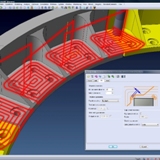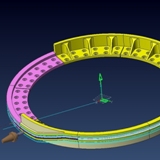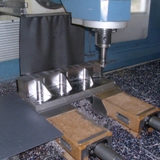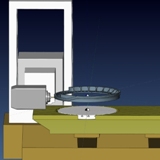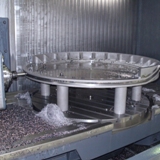TC Contact Use VISI, For Better 5-Axis Accuracy
One of the Slovak Republic’s leading engineering companies progressed to continuous 5-axis machining when its customers’ components became too complex for classic 3D machining.
TC Contact’s non-standard, one-off and single purpose machinery, equipment and technological complexes (including their electronic control systems) are used in the automotive and electrical engineering industries, along with a number of banks in Munich, Zurich and Rome.
"When using 5-axis continuous machining there are high demands on surface quality. VISI creates each toolpath with an even distribution of co-ordinates. By sending smooth and efficient CNC code to the machine tool control, it reduces unnecessary vibration and lessens the impact on thin rib geometry."
Pavol Mihala, EDGECAM | Designer and Technologist
“When the components are particularly complex, they can be very difficult to produce,” says EDGECAM | Designer and Technologist Pavol Mihala. “But using VISI software ensures accurate, high-precision machining, and makes all our jobs much easier. It also saves time during the modelling stage, and creates perfect NC programs throughout the production process.”
Based at Nove Mesto nad Váhom, TC Contact first installed VISI Modelling, 3D Machining including Adaptive roughing, and VISI wire erosion in 2008.
“We were looking in particular for specialised support for importing and editing external files and producing NC programs.” Pavol Mihala says their specific requirements from the software were:
• The import of external models and further editing
• The creation and modification of 2D drawings and 3D models of parts
• Reliable and efficient programming of 3-axis CNC machines.
“VISI CAD/CAM software met all those requirements, and while TC Contact also had other CAD programs, the design department relied solely on VISI.”
And he says VISI proved it was equally as good with 5-axis machining. “The growing number of complex 3D surfaces that we couldn’t produce with classic 3D machining forced us to expand production to 5-axis milling and we purchased a 5-axis HURON KX 15 CNC machining centre, and a DMG DMF-260/1100 5-axis centre.”
Postprocessors for the two new machines were created by VISI reseller VISI spol. s.r.o., and TC Contact suddenly found their production capabilities had significantly expanded.
Pavol Mihala cites manufacturing cams for a long-standing customer as being a perfect example of how VISI software is used right across their manufacturing operation. “We utilise all the features and benefits of VISI 5-Axis Machining, and use many machining strategies during the cam manufacturing process, from 2D to index and continuous 5-axis.”
He says positional (3+2) machining is used for machining the cam segments which are later bolted together. “It allows both 2D and 3D toolpaths to be used at a fixed angle. The traditional benefit is the reduction of multiple setup. The ability to orientate the head to the correct position automatically, significantly cuts machining time and significantly reduces the need for multiple fixtures. Positional machining is similar to continuous 5-axis in that it allows the machining of undercuts and enables shortened cutters to be used for rigidity and improved surface finish.”
Full continuous 5-axis machining starts after the cam’s segments are bolted together. “When using 5-axis continuous machining there are high demands on surface quality. VISI creates each toolpath with an even distribution of co-ordinates. By sending smooth and efficient CNC code to the machine tool control, it reduces unnecessary vibration, and lessens the impact on thin rib geometry.
“A high quality surface is a critical requirement for finish machining, and with VISI any surface marks can be eliminated using smooth axis movements.”
VISI’s trimming strategy was also used for the cam 5-axis machining. “For this type of strategy, for groove milling and boundary trimming, we calculate the tool position normal to the face direction following a drive curve. For additional control, synchronisation curves control the tool movement in local areas.
“We find VISI’s toolpath simulation and collision detection to be invaluable tools, as potential direction changes are at their most extreme when using this type of strategy. Collision avoidance includes cutter retraction along the tool axis, tool tilting to prevent holder collisions, and pulling the tool away from the work piece in a given direction.”
In addition, the rotation axis can also be restricted to user-defined limits, preventing the spindle from over travelling.
VISI spol. s.r.o. created a model of the machining centre so it can be authentically and reliably represented in VISI’s kinematic machining simulator. Toolpath verification is applied using the real machine dimensions and limits with the kinematic simulation including the motion display of all rotational and linear axes.
Cutting tool, holders, jigs and fixtures can all be checked when running the display. Any gouges on the toolpath against stock, tool or any other part of the machine tool are graphically highlighted.
“After the simulation, we can safely proceed to the machining, knowing that the toolpath is perfectly safe and accurate.”
About The Company:
Name: TC Contact
Web: www.tccontact.sk
Benefits Achieved:
- Easy processing and editing of external, imported models and drawings
- Optimising 2D, 3D and 5-axis machining
- Elimination of time-consuming manual data entry
Comments:
"When the components are particularly complex, they can be very difficult to produce. But VISI software ensures accurate, high precision machining."
Pavol Mihala EDGECAM | Designer and Technologist








